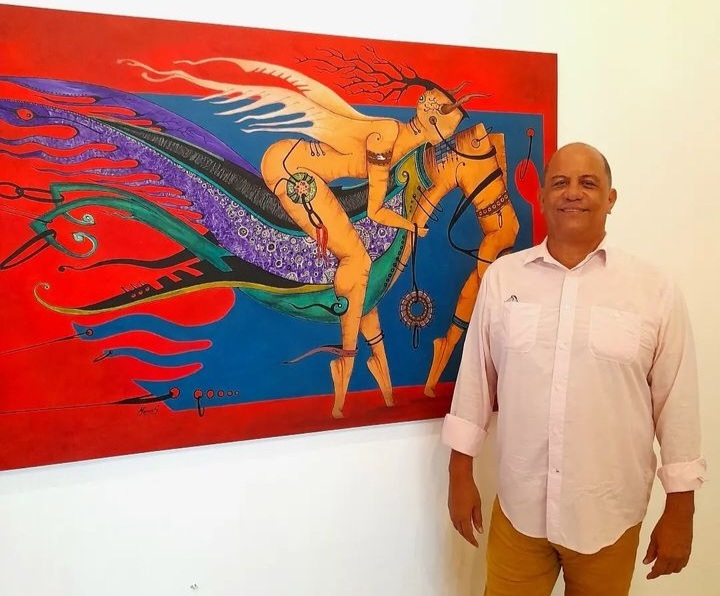Moisés González Acosta: «I Paint to Face Ghosts»
especiales

Since May 9, the Línea y Paseo gallery has hosted the exhibition Code 60, by visual artist Moisés González Acosta. The stylized figuration, in which the recreation of the female figure stands out, becomes, according to curator Teresa Toranzo, a profound evaluation of the most recent historical past, a dialogue that weaves together figuration, dreamlike, symbolism, and expressionism.
This Friday, June 7, the exhibition catalog will be presented. We spoke exclusively with the creator.
—What are the motivations for the exhibition?
—The life of a creator, like that of any human being, is encrypted by many events. Code 60, more than a title, is a wake-up call, a reason, an intention to approach my life and that of a generation through art. I, like many, have been a child of my time. A time of many changes, of many transformations. The main motivation is given by the need to express the feelings of a generation that like me has had a paved road, the need to show my good or bad experiences through painting.
«Code because I understand that in my work the elements of reality are encrypted in various patterns that are repeated over and over again, creating certain symbols that the public will or will not decipher. Gears, legs, ties, lines, wings, colors... 60 because I was born in 1960. A year that marked a turning point in the sociocultural and political life of my country. In the following decades, these changes would be consolidated in the minds and bodies of an entire generation, giving rise to new ways of seeing, understanding and relating to each other as individuals and society. These social transformations are reflected in a good part of my creation, at least those that have affected me, for better or worse. "Here they are shown from a code that does not precisely respond to reality."
—To what extent is your painting a narrative? How much of you is there in your work?
—My work is a narrative work, not just mine, sometimes I also show stories of other people or events that somehow awaken in me the need to show it, be it good or bad, in a more poetic way, so that the recipient feel trapped by the speech. Specifically in Code 60 I make a self-referential narrative but because it’s like that it does not stop being universal, because in each of these events anyone can see themselves reflected.
«In Code 60 there’s a lot of me. It’s the narrative of a life that has not been linear, with a very paved road, with many difficulties that, as I tell you, could be anyone's. I don’t believe that getting here has paved the way, I know that I still have many difficulties and setbacks to overcome, I still have many obstacles. "I will get up again and again, and as one of my pieces states, I will not fall."
—Some identify the color red with passion and violence, how do you assume it?
—I literally wanted to paint with the blood that runs through my body, but I had and have a lot to say. In the studies I did I knew that I couldn't, I would die trying. Above all, because of the time I worked on these pieces. I do not assume the color red only because of violence. The color red in Code 60 is a symbol of my blood, the blood with which I wanted to paint and couldn't; but not only because of the blood itself and the violence or violence that can be interpreted from that, but because it’s something I carry within, just like my experiences, which could be those of any human being. In the work there’s love, violence, passion, desires, growth, dreams, eroticism, fighting spirit, migration is approached too; this is how I assume it, with different meanings.
—What are your pictorial references?

—Since I was very little I was surrounded by art: paintings, drawings, sculptures, models. The works of my uncles Eladio González Herrera, painter and sculptor, who has lived in Chicago for more than 50 years; and that of Jesús González Herrera, now deceased, were my first contact with art. Like many at that time, we were affected by family separations. I was not free from it; but somehow those memories remained in my subconscious, nourished by the efforts of my aunt who, secretly from my father, showed me the progress of my uncle Eladio when she saw my inclination for drawing and the effort I put into my small figures in plasticine, with an unusual skill for a child of 3-5 years of age.
«Over the years and in my self-education I have studied the work of many artists. This universe is very broad, but those I have felt most identified with and perhaps influenced by in some way have been Wifredo Lam and Joan Miró.
—Why do you paint?
—Painting is my passion. I paint because it’s the way to express and confront all those ghosts that surround me. It’s the way to express everything I see, what I experience, what people I know and those I don't, experience. It’s the way to move to another dimension that sometimes is difficult for me to leave. It’s a way of self-healing. It’s a way to make the world reflect and raise concerns. When I paint I live in a parallel world where everything is possible.
The exhibition catalog will be presented at the gallery, Línea Street, No. 754 Altos, between Paseo and 2, El Vedado.
Translated by Amilkal Labañino / CubaSí Translation Staff














Add new comment